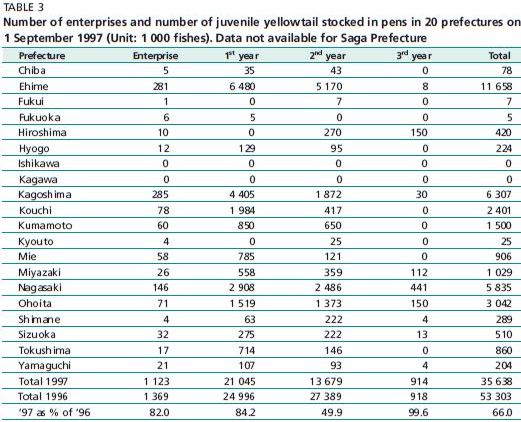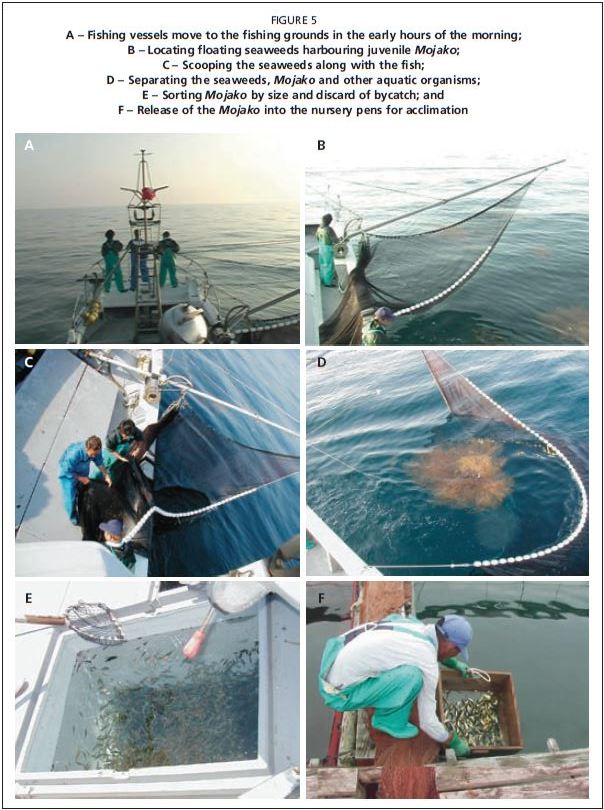DESCRIPTION OF THE FISHING ACTIVITY
Yellowtail spawning areas and seasons have been described by the Japan National Sea Fisheries Research Institute of the Fisheries Research Agency (Figure 4). In the southern parts of the East China Sea, the fish spawn from early February until April. Following spawning the young Mojako drift to the Pacific Ocean in association with floating seaweed. Off the west coast of Kyusyu, spawning occurs mainly from March to June and most of the Mojako drift through the Tsusima warm current to the Sea of Japan. Spawning areas and seasons move north to the 20 to 22 ?C water temperature off Sizuoka from May to June, and to Toyama from July to August.
Fry of yellowtail and related species seek protection in seaweeds that break off the bottom of the sea, and feed on micro-organisms and small fishes while drifting north with the current. Small Mojako (4–5 cm long) usually stay under or inside the floating seaweed, while larger fish swim 0.5–2 m below the surface. Mojako feed actively at sunrise and sunset when swarms of zooplankton can be detected; during the day they feed on small fish (Sakakura and Tsukamoto, 1996; Anraku and Azeta, 1967). After reaching 10–14 cm in length, the Mojako leave the floating seaweed and swim towards the shore, where they are targeted by the set nets (Ikehara, 1984).
Wild Mojako juveniles for aquaculture are harvested from the floating seaweeds, by experienced crew using specifically designed fishing vessels (Figure 5). In contrast, wild yellowtail for human consumption are caught using set nets, tow nets and round haul nets from the shore.
Statistics and trends in the amount and sizes of juveniles caught
The number and size of Mojako captured by the prefectural fisheries organizations have changed in recent years, largely due to changes in the amount of drifting seaweed in the South Seas (Table 3). Furthermore, the size of captured Mojako differs by area and month, influenced by water temperature and nutrients in the sea.
FIGURE 4
Yellowtail spawning areas and seasonal changes Source: Japan National Sea Fisheries Research Institute.

TABLE 3
Number of enterprises and number of juvenile yellowtail stocked in pens in 20 prefectures on 1 September 1997 (Unit: 1 000 fishes). Data not available for Saga Prefecture

FIGURE 5
A – Fishing vessels move to the fishing grounds in the early hours of the morning; B – Locating floating seaweeds harbouring juvenile Mojako;
C – Scooping the seaweeds along with the fish;
D – Separating the seaweeds, Mojako and other aquatic organisms;
E – Sorting Mojako by size and discard of bycatch; and
F – Release of the Mojako into the nursery pens for acclimation

Seasonality of fishing activities
From early March, the early juveniles (Mojako) are collected from drifting seaweed and then raised until they reach 2 000 g, which is achieved by the end of the year. The harvest season and size are regulated by the fisheries station in each prefecture. Usually the Mojako season opens in May at Kagoshima Prefecture, and in June at Mie Prefecture.
Participants in the fishery and their roles
Mojako fishing is dangerous work in rough seas, and workers need experience, special knowledge and intuition. After harvest, the juvenile fish are put into small net cages (5 x 5 x 5 m), and older workers feed them with minced raw feed fish or granulated feed more than 5 times per day. The former feed type is problematic, because it quickly pollutes the water, the Mojako lose their appetite and may develop gill problems. The granulated feed is preferred, and is given as soon as possible, even while the juvenile Mojako are in the holding tanks on the fishing boats. Granulated feed for marine juvenile fish results in a high survival and growth rate, and Mojako as small as 0.2 g easily domesticate and grow well.
Larger yellowtail Mojako are fed extruded pellets weighing 5 g or more, twice daily. As the fish grow, they are graded and transferred into 7 x 7 x 7 to 10 x 10 x 10 metre net cages. When the fish become 200 g or more (called Hamachi), they are fed moist pellets, which are prepared by the younger workers on the boats and distributed via mechanical feeders.
Seed handling procedures at sea
If the fishing areas for Mojako are very far from port, there is a long period when the fish are held on board, during which time the juveniles may prey on each other whilst in the holding tanks. To reduce cannibalism, they are fed minced fish which often causes the water to deteriorate rapidly due to food wastes and faeces. Newly developed granulated feeds have been fed successfully to the juveniles during transport to the net cages. These feeds have a high palatability, do not pollute the holding water and are easily taken by fish as small as 0.2 g. Wild Mojako weaned on granulated feed tend to perform well during subsequent culturing.